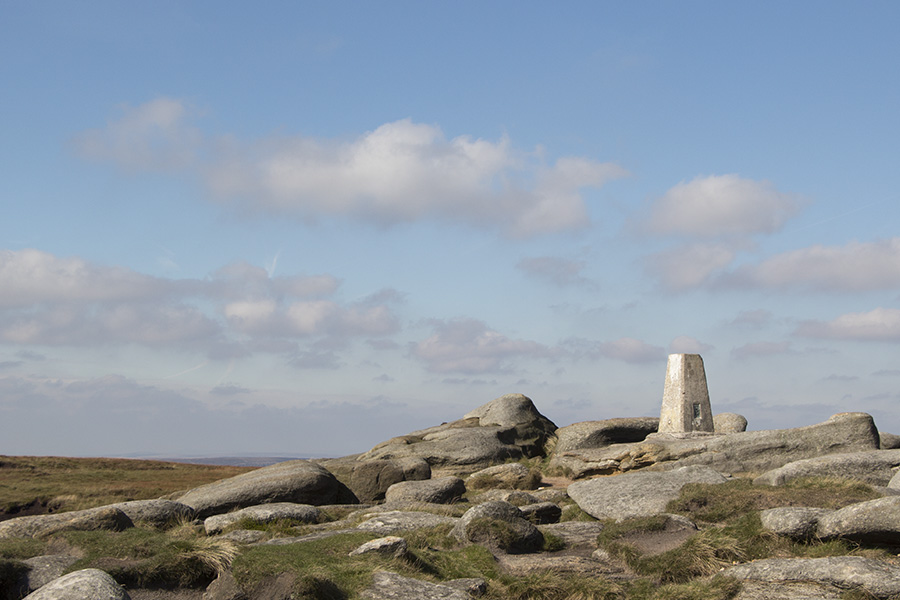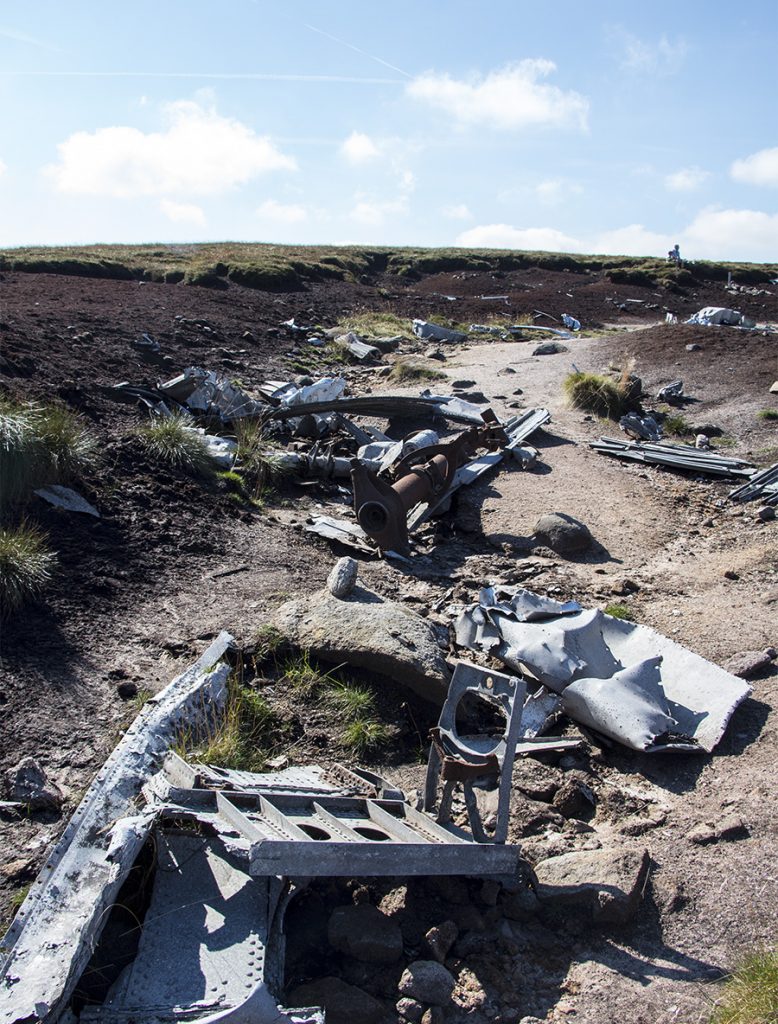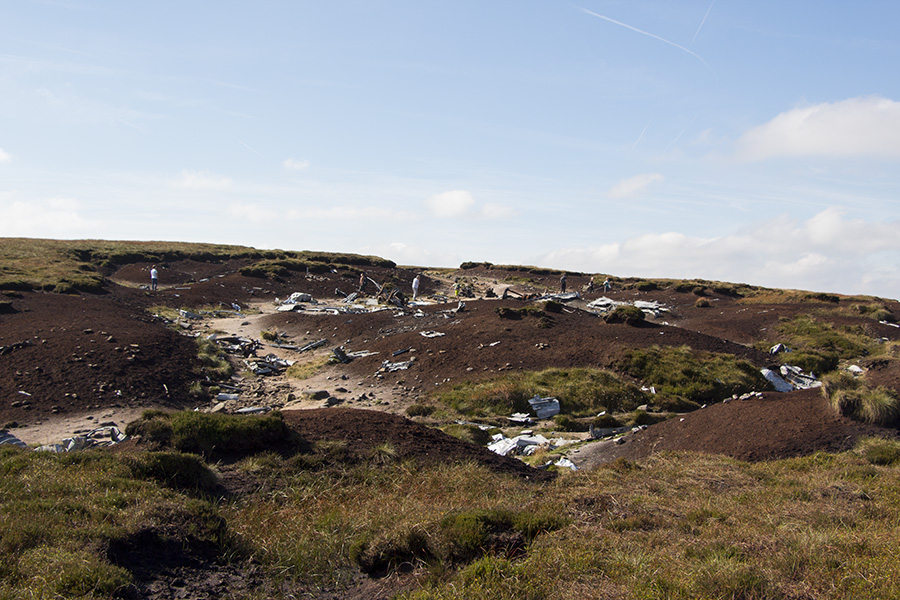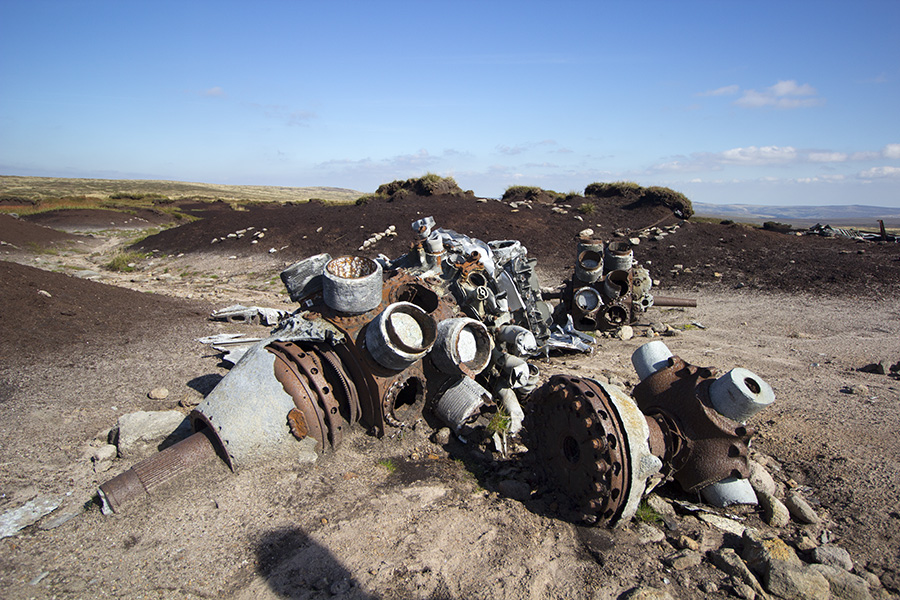One of the most evocative locations in the Peak District is the site of the crash of the Boeing RB-29 Superfortress “Over Exposed”. The wreckage covers a wide area and is a well known feature for hikers on the Pennine Way in the Peaks, though hidden from view until you almost stumble upon it on the way to Higher Shelf Stones.
The easiest way to find the crash site is to follow the Penine Way North from the A57 Snake Pass (SK088929). There are laybys at either side of the road but take care when parking as the road surface is significantly higher than the gravel parking areas and some cars may ground. Follow the Pennine Way until it crosses Hern Clough at SK097947, from here head West towards the trigpoint on Higher Shelf Stones at SK089948. Before you reach the trigpoint you will encounter the crash site.

Bleaklow is usually wet, even in the driest of years so make sure you’re prepared for this. Most of the Pennine Way is paved until you approach Hern Clough but from then on, particularly as you head west across the boggy moor you will get your boots wet.
Many of the larger pieces of wreckage are grouped together in a depression but a quick scout around the site reveals other sections of fuselage and mechanical components. The engines and undercarriage sections cannot have come to rest in such close proximity and must have been moved there after the crash. More on this below but first a few words about the trigpoint at Higher Shelf Stones.
Apart from the walk across boggy ground this trigpoint is a relatively easy one to get to if you only walk from the A57. The views of Glossop and the surrounding moorland it affords are superb in almost any weather. Though the area does have a tendency towards mist and fog so don’t be surprised if visibility is low in autumn. However, pick your day carefully and you’ll have ample opportunity to take some stunning shots from the top. Of course, easy access and great views mean it can get busy too.
The Aircraft and The Crash
Over Exposed was a reconnaissance RB-29 version of the famous Boeing B29 Superfortress bomber. The aircraft was one of the largest to fly during WWII and saw service into the Korean war with the US and other airforces. The B-29 was rushed out at the end of the war to be used as part of the invasion of the Japanese mainland where intense bombing of Japanese cities became seen as the only way to prevent huge casualties amongst the planned invading forces.
The B-29 has the dubious distinction of being the only aircraft ever to have dropped nuclear weapons in combat (“Enola Gay” on Hiroshima and “Bockscar” on Nagasaki).
The reason for the aircraft’s crash is a little mysterious due to the sudden and catastrophic nature of its impact with the moor. On 3 November 1948 it took off from RAF Scampton bound for RAF Burtonwood carrying wages and 2 or three passengers not part of the aircraft’s normal compliment. About 30 minutes before landing the pilot seems to have chosen to descend, the result of which was to crash the plane directly into the hillside at several hundred miles per hour.

Why such an experienced flier did this is not clear but it seems probable that three things played their part:
- Cloud cover was low, below the height of Bleaklow.
- The navigator was using dead reckoning as was standard practice at the time, using airspeed and time to calculate the position of the aircraft and course changes. Because of a strong headwind this probably meant the aircrew thought they were closer to Burtonwood than they actually were.
- Their altimeter may have been faulty, reading higher than it should.
In short the crew thought they were on approach to Burtonwood and began a normal descent. If the cloud base had been higher visual cues would have alerted them to the mistake, if their altimeter had been working correctly they may have left more margin in case of high ground suddenly rearing up in the dense cloud. As it was circumstances conspired to kill the 13 crew instantly.
“Over Exposed” had been in service just 4 years.
After the crash the tail section, visible for miles around had to be demolished as it was a draw to sightseers. Despite this over the last seven decades sections of the wreckage have been removed by individuals that I’ve seen referred to as “collectors” though I think of as vandals.
The Crew of RB-29 44-61999 “Over Exposed”
| Captain Landon P. Tanner | Pilot |
| Captain Harry Stroud | Co-Pilot |
| Technical Sergeant Ralph Fields | Engineer |
| Sergeant Charles Wilbanks | Navigator |
| Staff Sergeant Gene A. Gartner | Radio Operator |
| David D. Moore | Radio Operator |
| Technical Sergeant Saul R. Banks | Camera operator |
| Sergeant Donald R. Abrogast | Camera operator |
| Sergeant Robert I. Doyle | Camera operator |
| William M. Burrows | Private First Class |
| Corporal M. Franssen | |
| Corporal George Ingram | |
| Captain Howard Keel | 4201st Motion Picture Unit |








Recent Comments